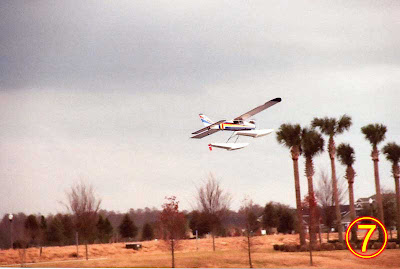Wow! That was fun! I took the float plane to a large pond about two miles from where I live. I have to admit I was nervous. This is a first for me, to fly off of water.
I had been by the retention pond earlier in the day and the wind was out of the southeast. Well, now it was out of the northwest. I had decided upon a place to launch the plane but had to change that. That was no problem. The banks weren't too muddy. I fueled the plane and sat it in the water. I have been afraid that, sitting on the ground, the plane will rest on the water rudder. It doesn't, it rolls forward to the front of the floats. This was a nice surprise. After my last little crash with the trainer, the throttle linkage had come undone. I put it all where I thought it should be and the throttle ended up being better than before. I fueled the plane, started her up and put her in the water.

I taxied around for a little bit to see how the water rudder worked. It worked well! I had probably a small 12 to 15 mph crosswind which required a little extra throttle when turning out of the wind. Everything seemed to be working well so I pushed the throttle forward and the plane hurried across the water. The floats rose up out of the water and the plane wanted to take off prematurely. I pushed the nose down to make sure I had ample airspeed to get airborne. I have heard stories that floats will "stick" to the water. I guess it is due to the surface tension of the water. Well, mine did. It wasn't really a problem, it just takes a little extra elevator to lift off. Then once the plane leaves the water, you have to push the nose down. I like flying with a little wind. I always tell people, "Where I grew up (the Texas panhandle), if you don't fly in the wind, you just don't fly." I actually test flew my Goldberg Skylark 56 Mk II ARF in 25 mph gusts.

The floatplane felt a little tail heavy to me. Always remember, it is better to be just a little nose heavy than to be a little tail heavy. The tail heaviness was with a full tank of fuel. The center of gravity falls about an inch or two behind where it does on the plane without floats. I will add weights to the front of the floats so that the center of gravity will still be correct when I take the floats off and put wheels back on. As with any flat bottom wing, turning into the wind causes the airplane to balloon! I did some slow speed, low passes over the water before I attempted a landing. Wow, this thing really slows down. I can have so much fun with a trainer. After flying sport and pattern planes, all RC pilots could enjoy getting back to the basics. When I made my landing approach, I came in low over my pickup and floated the plane in and adding just a touch of throttle at landing, the airplane landed very smoothly. I shot a few touch and goes and then landed to check my fuel situation. With any new plane it is important to know how long you can fly before running out of fuel. I didn't want to have to bring this thing in deadstick in the weeds and tear up all the work I've done! By this time, it was starting to mist outside. I took the wings off the plane and put it in my pickup. I sat there for awhile and the mist slowed down so I put the wing back on and flew the airplane again. After a few more touch and goes, the mist was starting to turn to rain so I decided it was time to pack it up.
The retention pond had some cat tails in a couple of spots that I had to avoid. They would do a job on a wing if you hit them hard. When I was taxiing back to the shore, I couldn't turn out of the wind and ended up against the cat tails. The only thing to do was go after the plane. I pulled everything out of my pockets and went in. The water was up to my ribs and it is probably in the high 40's today. The water really wasn't too bad. I got the plane loaded up, got home and got a shower!
On one of the touch and goes, the left float "slapped" the water and I noticed when I put the plane in my truck that some of the Monokote is torn off. I know Monokote is not designed for this type of use but I REALLY don't want to have to paint these floats. I will assess the damage later and iron on more Monokote.
As far as flying at sea level, I could definitely tell a difference. I normally use an 11x7 propeller on my .61 engines. For this plane with the floats, I decided to go with a 12x6. This gives a better climb performance which I figured can't be a bad idea considering the plane is not only pulling the extra weight of the floats but also the extra drag. The climb out was incredible because of the elevation and the prop. Then, when I was on landing approach, the airplane would really float. I had to go around two or three times and come in right over my pickup and I was still landing about half way out in the pond. I am used to planes dropping like a rock, especially on really hot days.
Overall, this was a great experience. I am going to LOVE float flying!























